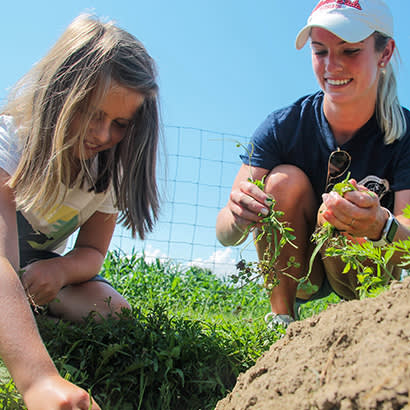
For an enhanced digital experience, read this story in the ezine.
Park and recreation leaders provide essential services during COVID-19 pandemic
When the COVID-19 pandemic hit, Glenview Park District in Illinois was forced to close its facilities and halt in-person programming as physical distancing and stay-at-home orders were implemented to protect the health and safety of residents. Despite these obstacles, park and recreation professionals in the district remain committed to providing essential needs to the community. Staff that manage one of the district’s assets, Historic Wagner Farm, are keeping that promise by expanding agricultural education to include food production to address food insecurity in Glenview.
An active dairy farm dating back to the 1840s, Wagner Farm was acquired by the park district in 2000. According to Jonathan Kuester, the farm’s director, its mission for the past two decades has been teaching agriculture. “The farm is set up as a 1920s living history farm, so we did a lot of 1920s activities,” he says, “but we also did a lot of modern agriculture education as a subcomponent of that.”
However, those activities were disrupted by the outbreak. The crisis compelled the Glenview community to create a local taskforce to monitor the coronavirus situation and share updates from the local hospital system, food pantry and other local government agencies. Jena Johnson, director of brand strategies and community engagement for the park district, says, “When we started experiencing the shutdown…the food pantry continued to report increasing numbers of first-time families visiting the food pantry. So, we did hear and see that there was an increasing need in our community for food. And, at the same time, we had closed our facility, but that doesn’t mean chickens stop laying eggs. At a farm, things just keep moving.”
The farm’s 80 pasture-raised hens continued to produce eggs — more than 1,000 — and fruits and vegetables continued to grow. Because of the livestock and land that was being actively farmed, “it was decided at the beginning that we were going to maintain those assets,” says Kuester. “We were directed to keep growing and keep the livestock healthy and doing what they do. Beyond that, we really weren’t given a lot of direction. We were focused on closing everything down and trying to make everything safe.”
Kuester took on this initial challenge while his staff of more than 50 employees was reduced to only three members due to the economic impact of the pandemic. Yet, even with a highly reduced workforce, Kuester and his employees were determined to do more than keep the farm afloat. “My staff...decided that we could just do chores and call it ‘good,’ or we could try to do something,” he says. So they decided to do what they knew how to do — grow food.
The pasture will now support 100 chickens, 25 Thanksgiving turkeys, 10 lambs, eight hogs and one beef steer — an expansion that allows for greater food offerings — and the eggs and produce harvested become a weekly donation to the local food pantry. The farm has also partnered with the Northern Suburban Special Education District on a Community Supported Agriculture (CSA) program. According to the park district’s press release, farm staff hope to produce more than 20,000 pounds of fresh produce and 6,000 pounds of meat and eggs — enough food to feed nearly 50 households every week for the entire season.
Johnson asserts, “Our vision is to help everyone in our community appreciate nature and experience health and happiness on a daily basis, so we’ve...tried to use that [vision] as inspiration for how we do that in a new format. I think this farm transition is just one piece of that overall transition we’re making as an organization.”
Lindsay Hogeboom is Associate Editor for Parks & Recreation magazine.

